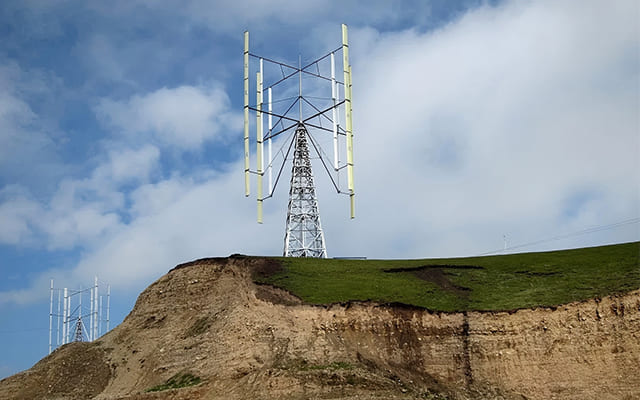Among the common types of wind turbines, horizontal axis wind turbines (HAWT) have long dominated the market. However, with advances in wind power theory, improvements in real-world applications, and the growing trend toward turbine scaling, the advantages of the vertical windmill generator are becoming increasingly recognized.
Here are the key benefits that make vertical windmill generators stand out:
1. Ultra-Quiet Operation
A vertical windmill generator starts generating electricity at very low RPMs—around a few dozen revolutions per minute—and reaches its rated speed at roughly 200 RPM. This results in extremely low noise levels, making it ideal for residential areas, schools, parks, and other noise-sensitive environments. In contrast, horizontal turbines often generate noticeable and sometimes disturbing wind noise.
2. Wider Wind Speed Range
Vertical windmill generators can operate efficiently across a broad wind speed range (1–28 m/s). This makes them well-suited for regions with low or variable wind speeds, where traditional horizontal turbines may underperform.
3. Environmentally Friendly and Safe
With low rotational speeds, vertical turbines are less likely to harm birds or flying wildlife. They also do not require lubricating oil, eliminating the risk of leakage and protecting sensitive environments like wetlands, grasslands, or nature reserves from contamination.
4. Stronger Resistance to Extreme Weather
Vertical windmill generators are structurally stable and can withstand extreme gusts up to 50 m/s, outperforming horizontal turbines in storm-prone or coastal areas. This makes them a reliable choice for disaster-resilient installations.
5. Compact Footprint for Better Land Use
Due to their smaller operating radius, vertical windmill generators take up less space, allowing more flexible placement and higher density in wind farms. This helps conserve land, especially in urban, mountainous, or high-value real estate areas.
6. Higher Output in Medium Wind Speeds
In the wind speed range of 5 to 9 m/s, vertical windmill generators often deliver 15%–25% more output compared to similar horizontal-axis models. This makes them particularly efficient in low to medium wind zones, and ideal for off-grid systems, home use, or telecom applications.
7. Easier Maintenance, Lower O&M Costs
A major advantage of vertical windmill generators is ease of maintenance. Because key components such as the generator and controller are usually located at ground level, there is no need for high-altitude servicing. This significantly reduces maintenance costs and risks compared to HAWTs that require specialized equipment and personnel for tower-top access.
8. No Need for Wind Direction Alignment
One of the standout features of a vertical windmill generator is its ability to capture wind from any direction without requiring a yaw mechanism. This simplifies the design, enhances reliability, and reduces mechanical failure points.
9. Simple Braking System
The lower rotational speed of vertical wind turbines makes braking systems more straightforward and reliable. Emergency stops can be executed more safely and efficiently, reducing potential damage during high winds.
Although horizontal axis wind turbines remain dominant in the large-scale wind power industry, the vertical windmill generator is quickly gaining traction, especially in distributed energy systems, residential applications, and urban or remote environments. With their low noise, high safety, strong wind resistance, and minimal maintenance, vertical wind turbines are becoming an increasingly practical and eco-friendly solution for modern renewable energy needs.

